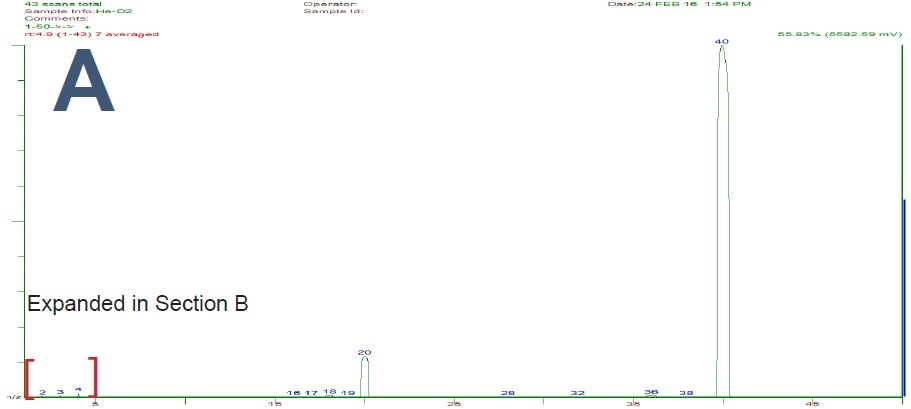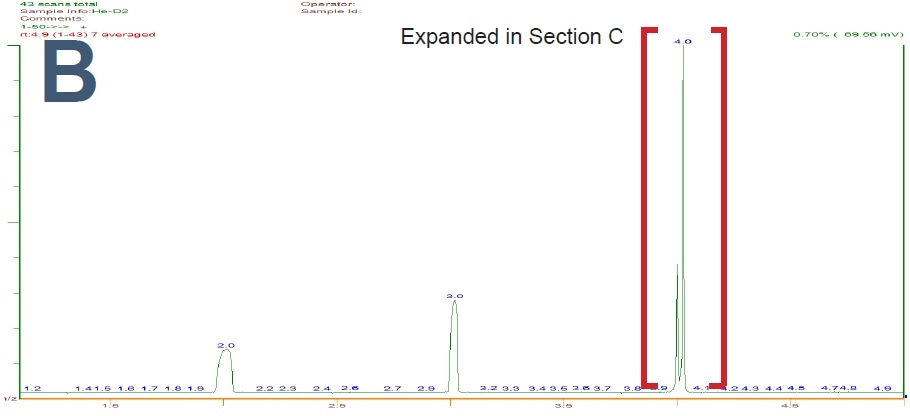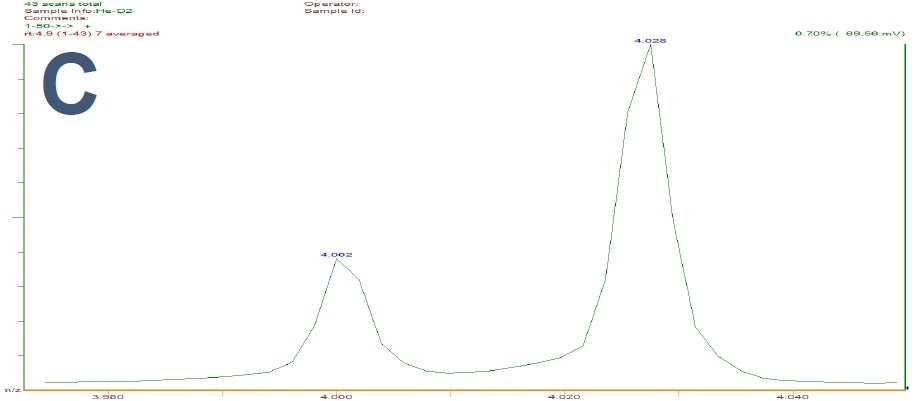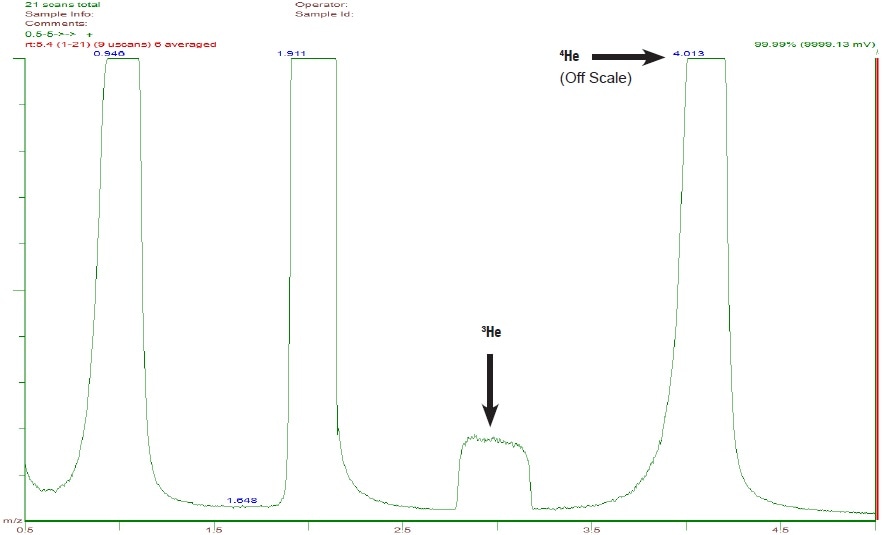The VeraSpec HRQ is a high resolution quadrupole mass spectrometer that delivers excellent ion transmission, resolution and abundance sensitivity for the fine isotopic analysis of low molecular weight gases.
- Nuclear Research
- Gas Production
- Fuel Cell Development
Although isobaric compounds have different structures and make-up, they have the same nominal mass. Slight, millidalton, differences in the exact mass of the ions can reveal their true composition. This level of fractional mass detail is needed in many applications in nuclear research, gas purity and fuel cell development to detect and measure low molecular weight species. However, it is very difficult to achieve this resolution in the low-mass range.
Advanced Core MS components are used by the VeraSpec HRQ to obtain the highest resolution to date in Extrel’s VeraSpec series of high-performance mass spectrometers. Using the Extrel high precision 2.9 MHz control electronics and 19 mm tri-filter quadrupole, the VeraSpec HRQ has a resolution >3000 (M/ΔM) across a 1-50 Da mass range.
Besides fractional mass analysis, the Merlin Automation™ Control Software adds exceptional, powerful features for complete characterization of samples. The Merlin software can scan for both negative and positive ions, and includes complete control of mass-specific resolution tuning. This enables users to define and perform a single, 50 Da scan with ultra-high resolution and accurate mass where it is required, and nominal mass resolution at other masses. This results in an analyzer that not only has remarkable flexibility but also has the ability to quantify the entire composition of the sample in each scan.

Figure 1. VeraSpec HRQ
A high resolution quadrupole mass spectrometer for the nuclear, gas production and fuel cell industries.
Hydrogen and Helium/Deuterium Analysis
Some of the most difficult low-mass applications include detecting helium leaks in a heavy hydrogen sample, or measuring hydrogen isotopes in the presence of helium. The VeraSpec’s ultra-high resolution can isolate the accurate mass peaks of deuterium and helium to baseline. In addition, the start of the scan is entirely free of on-blast (an elevated background near m/z 0), thus allowing accurate and precise analysis of hydrogen at m/z 1 (Figure 2).



Figure 2. The VeraSpec HRQ was used to analyze a mixture of argon, helium and deuterium. The three images above depict portions of the same scan, displayed with increasing resolution to show the level of detail within the data set.
A. The full scan from m/z 0.5-50 shows the mass spectrum of the sample. For the majority of the scan, including m/z 20 and 40 where argon appears, the analyzer was set for unit resolution to allow maximum ion transmission and sensitivity.
B. At m/z 5 and below however, the resolution was increased to completely separate the peaks of the low mass molecules.
C. Helium and deuterium both have a nominal mass of 4 Da, but the VeraSpec HRQ provides the complete separation and accurate mass of the two compounds in this sample.
Exceptional Abundance Sensitivity
Abundance sensitivity refers to the ratio of signal generated by a peak at its highest point to the amount of signal it generates at a point +/-1 Da on the mass range. Excellent abundance sensitivity is necessary to measure a trace component at an analytical mass that occurs within 1 Da of a major peak in the bulk gas spectrum. Also, ultra-high resolution gives the VeraSpec HRQ spectrometer an abundance sensitivity of better than 106. During the analysis of a helium sample, the peak from 3He can be easily differentiated from 4He in spite of the concentration of the larger isotope being more than 500,000 times greater (Figure 3).

Figure 3. A scan from m/z 0.5 to 5 showing the natural helium isotope 3He in a UHP helium sample. 3He is only 2 ppm relative to 4He, but the small peak is clearly visible, because the VeraSpec HRQ has an abundance sensitivity of 106.
The Extrel “Complete System” Advantage
The VeraSpec line of quadrupole mass spectrometers is the result of years of partnership between Extrel and its academic, research and industrial customers. Each VeraSpec analyzer is a turn-key solution, allowing users to focus on their work instead of constructing an analyzer.
- Design: Each application requires particular capabilities. Proven, preconfigured Extrel parts can be easily and quickly integrated into a mass spectrometer customized to the task at hand.
- Integration: System control, precision alignment and in-vacuum wiring can be complicated problems. Extrel analyzers are engineered with function and maintainability in mind, saving time and reducing costs down the road.
- Validation: Complete system stability and functionality are proven and documented before leaving the factory.
- Support: A qualified Extrel technician will be able to install the instrument, validating factory-run performance for optimum operation. Also, Extrel technical support guarantees that experts who know the users’ analyzer are available for assistance during the whole life of the system.
Application Specific Customization
The VeraSpec HRQ high resolution quadrupole mass spectrometer provides flexible inlet options for seamless sample integration:
- Conflat flange or VCR fittings for UHV operation, gas purity and leak-proof sample introduction, and assurance of safety in a challenging environment
- Load-lock style chamber for connecting to a glove box, furnace or other outgassing samples
- VCR fittings with metering and toggle valves for sample gases and calibration
- Custom designed inlets also available

Figure 4. A cutaway view of the probe in a VeraSpec HRQ with a pumped gas inlet.
Table 1. VeraSpec HRQ Mass Range Options.
| Mass Range |
Quadrupole Mass Filter |
Operating Frequency |
Relative Transmission |
Resolution
(M/ΔM FWHM) |
General Sensitivity
(mA/Torr) |
| 1-50 |
19 mm (3/4 inch) tri-filter |
2.9 MHz |
75% |
3000 |
4 |
| 1-120 |
19 mm (3/4 inch) tri-filter |
2.1 MHz |
65% |
2500 |
3 |
Installation Requirements:
- Recommended Power Supply:
- (2) 120 VAC, 50/60 Hz, 15 Amp circuit
- (2) 220 VAC, 50/60 Hz, 15 Amp circuit
- Ambient Temperature:
- 55 °F to 80 °F (13 °C to 27 °C)
- Relative Humidity: 0-90% non-condensing
- Analyzer Weight: 200-250 lbs (90-115 kg)
- Analyzer Dimensions:
- Height: 42.9” (109 cm)
- Depth: 40.0” (102 cm)
- Width: 23.1” (59 cm)
Merlin Automation Data System Software:
- Instrument Control: PC connected via USB or Ethernet
- Analysis Mode:
- Scan Mode
- Single Ion Monitoring (SIM)
- External Communications:
- Ethernet, digital I/O, analog I/O, OPC
Exceptional Worldwide Service and Support
For over 50 years, Extrel has been committed to offering maximum quality support services for numerous instruments installed around the world. Factory trained and certified personnel provide industry-leading support to Extrel customers at all stages of the combustion control application.